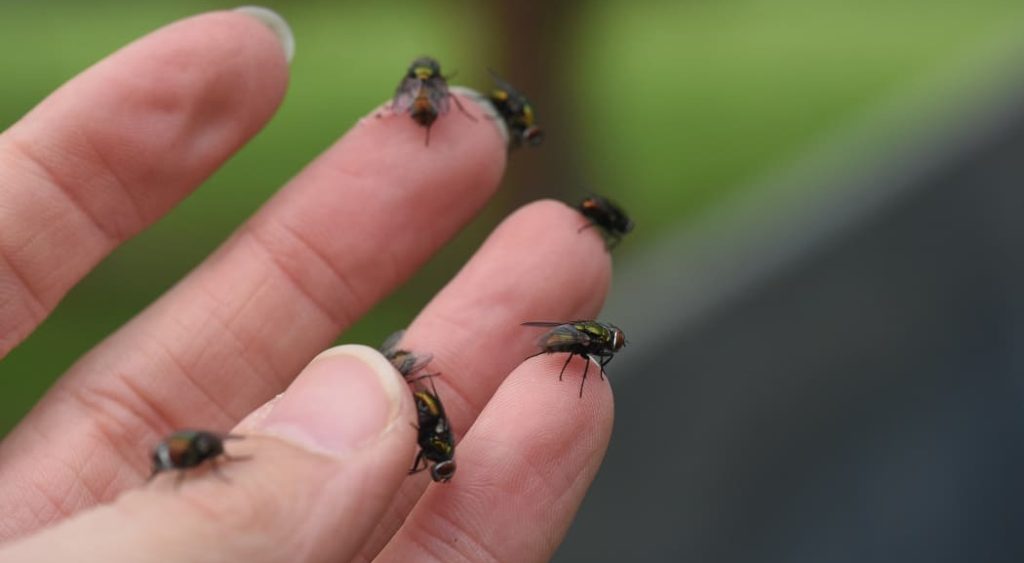
Green blowflies are the target on Kangaroo Island. Image – SARDI.
MILLIONS of sterilised sheep blowflies will be released on Kangaroo Island this month as part of a plan to potentially eliminate the costly pest.
A $3.45 million world-first demountable sterile blowfly breeding facility has been formally opened and will be producing enough sterile green blowflies — Lucilia cuprina — to release from 13 September.
The state-of-the-art Sterile Insect Technique facility has been constructed in shipping containers so it can be redeployed elsewhere in South Australia to continue the program throughout the state and potentially nationally.
The flies will be released as part of the SARDI-led $5.7 million SIT blowfly pilot project funded by Meat and Livestock Australia, Australian Wool Innovation, Animal Health Australia, the SA Sheep Industry Fund, and the University of Adelaide. The project’s goal is to deliver large scale releases and eradicate sheep blowfly from Kangaroo Island over 4-5 years.
Staff from the South Australian Research and Development Institute commenced mass rearing flies in April, with the first flies expected to be released this month. When at full capacity, possibly in 2025, the facility will allow up to 50 million blowflies per week to be reared and irradiated to render them sterile before release.
A cost benefit analysis has shown that eradicating sheep blowfly on Kangaroo Island could save producers an estimated $88 million over 25 years, will also improving animal wellbeing.
SIT is recognised as an effective option for management of insects, where large numbers of sterile male flies are released in the field. These flies mate with female flies which are then unable to lay eggs. The technique is already widely used successfully for other fly species, such as fruit flies in South Australia and screw-worm flies in North and Central America.
Chair of Agriculture Kangaroo Island chair and sheep farmer Jamie Heinrich said the eradication of this sheep blowfly will be a gamechanger for the sheep industry here on KI.
“Not only would it make management easier, but it will also be better for sheep welfare.
“The flystrike caused by these flies happens very fast and sheep can get to a bad stage very quickly, whereas flystrike from other species of flies happens much slower,” he said.
“This will drastically reduce the number of sheep impacted by flies, while also saving farmers a lot of time and money for fly management.”
South Australia’s Minister for Primary Industries and Regional Development Clare Scriven said the impacts of Australian sheep blowflies to sheep can be devastating and can have significant economic impacts on producers.
“Sheep blowflies can be completely eradicated from Kangaroo Island and this facility will be at the forefront of that mission.
“Its unique design – a world first for this type of facility – will allow it to be re-deployed elsewhere once this project is finished to give us great value for money on top of the fantastic outcomes it will achieve here on Kangaroo Island,” she said.
Assistant Minister for Agriculture, Fisheries and Forestry Anthony Chisholm said the Albanese Government and sheep producers across Australia are keen to see this program succeed in the hope this technology can be replicated on a broader scale.
“Collaboration is always key to solving pest issues in this space and that’s exactly what has happened under this extraordinary pilot, which has brought together so many different organisations under SARDI.”
Construction of the SIT facility was supported through the Local Economic Recovery program, jointly funded by the Commonwealth and South Australian Governments in response to the 2019-2020 bushfires that severely affected communities in Kangaroo Island and Cudlee Creek in South Australia.
Local Kangaroo Island building company Kauppila Pty Ltd completed the siteworks contract, with Adelaide-based GAAS Shipping Containers providing the modified shipping containers, and Bio-Strategy Pty Ltd providing the radiation equipment.

HAVE YOUR SAY